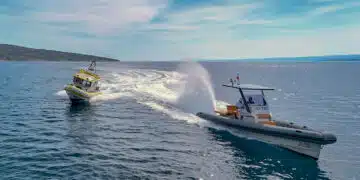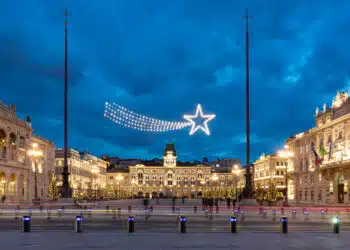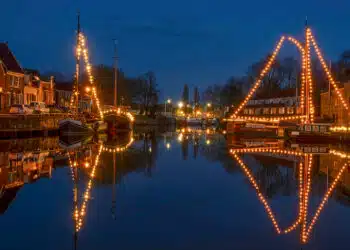The Scuderia 65, a racing sailboat created by designer Harry Miesbauer, was launched back in May 2020. It is made entirely from carbon sandwiches. Three years and four seasons later, one thing is certain: the yacht sails fast and is also well suited as a cruising boat thanks to its long-distance interior. This brings her pretty close to the ideal cruising yacht – at least for her owner. SeaHelp spoke to designer Harry Miesbauer about “ideal yachts”.
Hägar the Horrible, a comic strip invented by Dik Browne in 1973, is the leader of a group of Vikings who regularly set off on conquests, preferably to England. Hägar is regarded as a feared conqueror, but at home he presents himself as a caring family man whose business just happens to be plundering and pillaging.
HÄGAR is also the name of a racing sailboat whose spinnaker shows the likeness of the likeable Viking. What unites both the character HÄGAR and the sailing yacht is that you should actually be afraid of both: of the one, created by Dik Browne, because he does what Vikings supposedly like to do: go on raids. The other, HÄGAR, is the one to watch out for on the regatta fields. Because: the yacht called HÄGAR sails fast, very fast.
The designer Harry Miesbauer from Upper Austria designed the Scuderia 65 sailing yacht, which is suitable for racing and cruising
The racing sailing yacht was drawn by designer Harry Miesbauer, who was born in 1966 and comes from Upper Austria. Miesbauer, who has been sailing since the age of six and is himself an enthusiastic regatta sailor in dinghies and tall ships, graduated from the renowned yacht and powercraft design course in Southampton in 1998 after completing his mechanical engineering diploma in Austria.
Immediately after graduating, he worked for three years in Luca Brenta’s studio in Milan as a senior yacht designer and for a further three years between 2004 and 2007 as a senior yacht designer in the regatta projects department. In the second period he was also one of Luca Brenta’s partners; highlights of this collaboration bear such illustrious names as KENORA Wally 105, Wally B, CHRISCO CNB 100, TP52 C-QUADRAT, he designed the B yachts B-60, B-30, B-38, a Nautor 76 and others.
From 2000 to 2004 he worked as a senior designer at Mani Frers in the Italian Frers office in Milan; during this time he was a member of the design team of the Swedish Victory Challenge Americas Cup team and a member of the Volvo Ocean Race design team of Amers Sports One (VOR 60). And: during this time, Miesbauer was also responsible for various IMS racing boats.
Since 2007, Miesbauer has been running his own design office based in Italy and Austria
Finally, in 2007, the Upper Austrian, who also realized the design of the Frauscher motor yachts, founded his own studio /H/arry Miesbauer Yacht Design (hmyd) based in Como / Italy and Vienna / Austria, according to his own statements a “yacht design studio in the classic sense, which offers the complete package of yacht design – from ship architecture, ship and construction technology to exterior and interior design”.

Mr. Miesbauer, what does the ideal yacht look like for you?
For me, of course, the ideal yacht is a sailing yacht. That’s my story, my passion… Let’s call it what we want. But my ideal yacht must first and foremost follow the three basic principles of my studio’s design philosophy…. Bellezza / Eleganza / Performance….
Performance can only be achieved with a light boat. Once you have the performance under control, the Bellezza and Eleganza come naturally. Regarding Bellezza: I always tell my employees that we have to create beautiful things, after all, there are already enough ugly things in this world.
When it comes to a yacht for an owner/customer, the ideal yacht is the one that best realizes the design brief or the owner’s needs. Once we have achieved this, we can tackle Bellezza / Eleganza / Performance. However, the aim must always be that an owner should still be able to proudly say to the jetty where their yacht is moored five years later: “Look, that’s my yacht, isn’t it the most beautiful (la piu bella) in the entire marina?”.
But, having only designed racing yachts for a long time, we try to give performance as much of a role as possible in every new project. Speaking of lightweight boats: one aspect that many people don’t realize is that a lightweight boat is usually also a safer boat, because the loads on the rig, sheets, etc. are lower and therefore the risk of injury is also lower.
How did the Scuderia 65 come about?
The project started a few years ago when I sailed the ARC (the Atlantic Rally for Cruisers, editor’s note) with the owner of the current HÄGAR V. He is a passionate regatta sailor. He is a passionate regatta sailor and had a 62 at the time. I’ve known the owner for a long time and have sailed many regattas with him.
During the various night watches as we sailed across the Atlantic, we started to philosophize about what the ideal yacht should look like. The next day we had plenty of time and opportunity to try out different things. There were a few things that didn’t quite work as well as they should on the 62.
I made notes and drew the first sketches in my sketchbook, which I always have with me. However, the time was not yet ripe to tackle a new yacht, as the 62 was only three years old. About three years later, after we had sailed the Middle Sea Race together, he said on the plane back from Malta to Milan: “so now you can start with a 65 – but it should be really sexy”.
He initially only commissioned a design. In December 2016, I went to Bolzano with the first designs. He liked them so much that he commissioned the entire project and also the construction at Adria Sail in Fano / Italy at the same meeting.
What are the special features of the Scuderia 65?
When I had to deliver the final hull lines for the mould construction, I had worked out two versions: a hull optimized for light winds with less wetted surface, and one for more power with more dimensional stability. Together with the owner, we then opted for the second, i.e. the power hull. One reason for this was perhaps that the owner doesn’t like light wind racing so much.
The fact that it was the right decision was proven in 2022 at the Aegean 600 regatta: when the other yachts already had two reefs in the mainsail, we passed them with a full main in 25 to 30 knots of wind – certainly one of the reasons why we won this race.

Another feature of the Scuderia 65: the deck layout is completely optimized for offshore racing. Here we worked closely with Dede De Luca, President of OneSails, who is also tactician and crew manager on HÄGAR V at regattas, and Enrico Turini, trimmer on board. So many professionals have given their input into the development of the boat.
Speaking of performance: when I was on board myself, we managed an easy 20 knots of speed with 21 to 22 knots of wind. The current top speed – so far – is 28.7 knots! This was achieved with an overtake with cruising sails and only two crew on board. I think that with regatta sailing and a well-coordinated regatta team, 30 knots should definitely be achievable.
In this context, it is perhaps also interesting to mention that we were able to exceed our internal studio VPP calculations when sailing in winds over 20 knots (VPP or Velocity Prediction Program is a calculation software that estimates the performance of a sailing yacht based on certain boat and environmental data, editor’s note).
How did HÄGAR V perform on the regatta courses? Were the high expectations met?
Even in the first season, which could only be sailed in the Adriatic due to Covid, HÄGAR V showed her potential with various line honors and victories in IRC at the Circolo Nautico Port Santa Margherita (CNSM) long-distance regattas, and with an excellent 14th place at the Barcolana 2021 – with 1,700 participants! – showed their potential.
We have been able to optimize the light wind performance over the seasons, and as already mentioned, the top-class Aegean 600 was won overall in IRC and ORC in 2022, which was certainly the most important victory so far.
But apart from the successes on the water, the Scuderia 65 has shown that she also cuts a fine figure in terms of aesthetics and design by winning the A’ Design Award in the Yacht and marine Vessel category and a further two nominations at Yacht Design Awards.
The biggest award, however, came from the owner himself. He said after the Barcolana in Trieste that after all the miles he had sailed this season, he wouldn’t change anything about the boat.
Does this also apply to the interior?
Yes, completely. What has definitely proved its worth is the enclosed, U-shaped, well-equipped and very spacious galley on the port side right next to the lifting keel. You can cook there without any problems even in 30 to 35 knots of wind and corresponding swell.
The saloon itself is quite large and can be modularly arranged with the folding table. During the day, the passages to the navigation corner and the owner’s cabin are free; for dinner, you simply open up the table and sit comfortably.
The owner’s wife wanted a minimalist but elegant, timeless interior. We achieved this with cleverly graduated shades of gray and a few unique design details. One important feature is the flat deck structure with all-round windows. Nobody else does this on sailing yachts. It’s an aesthetic trick to stretch the appearance and give it a more elegant look.
I used a similar trick in the saloon, where I played with perspective. If you stand at the keel box and look aft at the companionway, the steps, which become narrower towards the top, lengthen the perspective.

Another nice detail, this time in the cockpit, can be found on the two control consoles. The owner wanted the control buttons for the hydraulic trim elements on the side of the console. So I ergonomically shaped the surface down towards the deck to accommodate the buttons. The throttle lever is recessed into the top of the console, where it is less noticeable.
After all, the boat should also be suitable for cruising… Unlike many fast IRC boats on the market, the Scuderia 65 was designed to provide a comfortable base even in cruising mode. There are three cabins, the owner’s cabin has a double bed to port, a dedicated sofa area to starboard and an en-suite bathroom with separate shower.
The two guest cabins with flexible double V-berths in the stern both have their own bathrooms with separate showers. In addition, the two guest cabins each have a tubular berth that can be used during regattas. All berths are adjustable so that you can sleep comfortably even when the boat is heeling.
At the opposite end of the U-shaped galley on the port side is a large navigation area on the starboard side, well equipped with a large monitor for navigation and weather data in large format. The entire interior is made of lightweight composite panels with a foam core. The ceiling panels are also super-light and have a Nomex honeycomb core. Appliances such as washing machines and ice-makers are modular so that they can be easily removed for regattas.
So is the Scuderia 65 really the ideal yacht?
I have now sailed more than 2,500 nautical miles in regatta mode and just over a week in crusing mode with the HÄGAR V. So, she comes very close to being the ideal yacht. As soon as there’s a bit of wind, she’s great fun to sail – the more wind, the better. In the wind, you almost think you’re sailing a dinghy.
The powerful hull lines always give you the feeling that you have everything under control. And in cruising mode, it is also easy to handle with two people. And the interior layout has also proved its worth, even in regatta mode, where the saloon can be cleared out and converted into a large sail storage area.
Basically, I believe that we have found the right balance with HÄGAR V: powerful in regatta mode on the one hand, and a yacht that is easy to sail across the Atlantic with friends on the other.
As a designer, I wouldn’t change the concept today. HÄGAR V is very sophisticated for its size. Perhaps today we would go one step further with the interior and make it even more modular so that we could clear out some things even more quickly and easily for regattas.
Winning the Aegean 600 in 2022 and various victories and podium finishes in other regattas, the Scuderia 65 has proven its performance. And after winning the A’ Design Award and other nominations for various design prizes, it is already clear that she will still be the same eye-catcher in five years’ time as she is today.
Further information:
Length HÄGAR V/Scuderia65 overall: 20.05 m
Length waterline: 18.60 m
Maximum width: 5.51 m
Displacement: approx. 19,500 kg
Draught: 4.50 – 2.95 m (lifting keel)
Total sail area: approx. 259.6 m²
Mainsail: approx. 152.0 m²
Foresail: approx. 110.10 m² (107%)
Gennaker: approx. 420.00 m²
Shipyard: Adria Sail / Fano, Italy



















